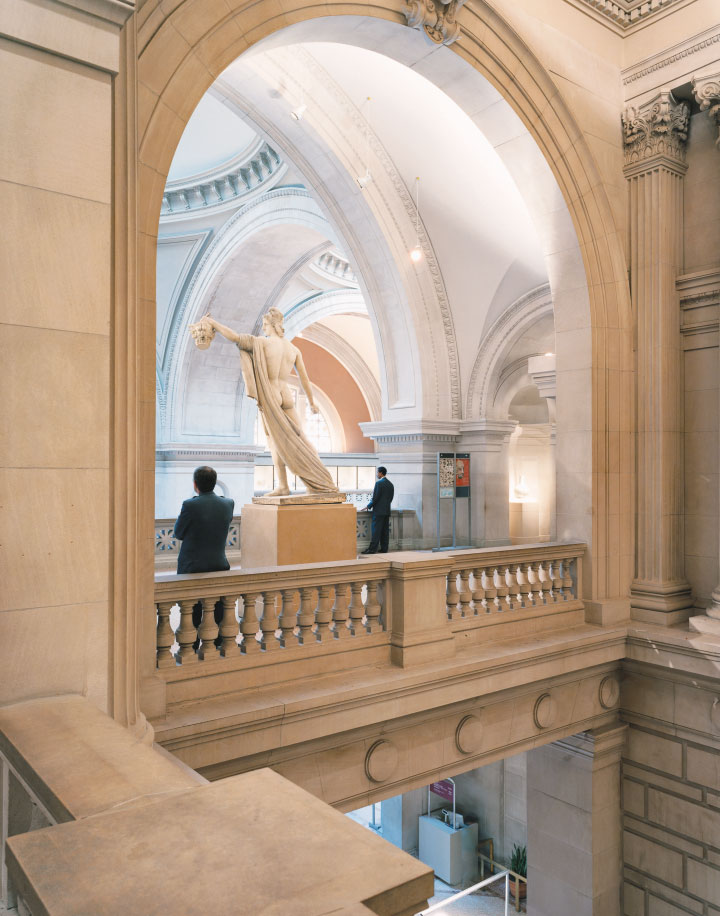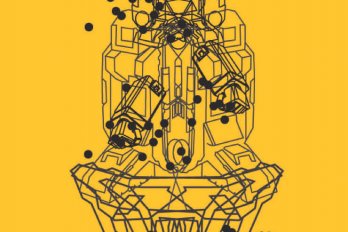
For a long time I made a living out of museums, which is not the same thing as living within them. I wrote about what they contained, and when I was clever enough about their contents, I was paid for it. In a career of particularly fatuous prescience about art, the most fatuously prescient essay I ever wrote was one that I published in 1992, called “The Death of an Audience.”
In it, I explained that the museum that we had known—the popular museum of the first three-quarters of the twentieth century—was on its way out, and that the audience for art that had filled museums for so long was being displaced by a coterie of professional observers. This argument was detailed, nuanced, reasonably arresting, and as wrong as any argument has ever been. What we’ve seen in the fifteen years since that essay was written is exactly the opposite: an explosion of the idea of the popular museum, a growth in audiences and attention that stretches from Bilbao in Spain to the new Royal Ontario Museum in Toronto.
Having given up the role of making a living from museums, I now find myself, ironically, living more than ever in them, as the father of two horribly overcultured children, who are constantly being dragged from theatre to museum, from Shakespeare to Rembrandt. Not long ago, I asked them which they actually enjoyed more—the theatre or the museum? My twelve-year-old son sighed and said, “Well, the theatre—you can sit down.” Then my seven-year-old daughter sighed as well and said, “Well, I prefer the museum—at least they let you talk.” At least they let you talk! Talking in museums is one of the things that makes them matter, and the way in which we talk in museums is one of the things that define for us what they are. Because museums, I think, as much as they are places to go and see things, are also places to go and talk about things, and, through talking, to understand something about the way life takes place in time.
Perhaps the earliest model of the museum is that of the museum as a mausoleum: the museum as a repository, a holding place—a tomb if you like, but a tomb where the past and its taste remain preserved. This idea of the museum as a mausoleum, as a place where you go to see old things, and where you go to find yourself as an aesthete or a scholar, is a very powerful one, and it governed the birth of the museum as we know it in the nineteenth century. We see it in the transformation of the Louvre from a palace into a museum; we see it in the formation of museums like the Metropolitan in New York and the Art Institute in Chicago. Like any mausoleum, it is a place above all connected to the past. It presupposes a certain kind of individual experience of works of art, or of works of nature, but always of things from the past, in which the essential hope was for a silent confrontation between a man or a woman and what we used to call our “heritage.”
One of the startling things you notice when reading about the experience of museums, even as late as the 1940s, is the degree to which they were silent and secluded places. John Updike’s great memoir-story, “Museums and Women,” written in the late 1960s, is based on his first experience of museums as a young boy growing up in semi-rural Pennsylvania in the 1940s, where the museums were provincial, and occasionally coming to New York, where the museums were not. What Updike was intrigued by was the eroticism of museums, their atmosphere of mystery, of silent entry; of pleasure, certainly, but pleasure of an enigmatic and enveloping sort. You went in with one companion—his mother at the beginning and then his wives later on—and the mystery of the museum echoed and predicted the mystery of sex. It held an air of silence and a promise of a kind of secret communion that would take place between the individual observer and the work of art or the object of the past.
In Robert Hughes’s new memoir, Things I Didn’t Know, you read, with less erotic sheen but equally intense significance, that one of the crucial experiences for Hughes as a young man in Europe, discovering art in the 1960s, was also the experience of museum silence. He writes about going to the Prado in Madrid for the first time, how serenely potent it was, without the crowds of mass tourists that would soon descend on it, and how that experience allowed a colonial boy from Australia to feel as though he was in a personal engagement with Goya and Velázquez, to re-enter the past through the portal of the museum.
The model of the museum as mausoleum was already on its way out by the end of the 1950s. In its place came the model of the museum as machine. By “machine” I don’t mean something mechanical, but something productive. I mean simply that a new idea had emerged of the museum as a place where you went to be transformed in another way—not a place where you went to commune with the past, but a place where you went to learn how to be modern.
The first museum I can remember seeing was the New York Guggenheim Museum on the morning it opened in 1959. My parents brought me, along with one of my many sisters, and we walked through it. We did it, I think now, as a form of education; to walk up and down that ramp, looking at Calders and Mirós, was to remake oneself, or try to, whether oneself was four years old or forty years old. That model of the museum as a machine for personal transformation was still in place when I moved to New York from Montreal in 1980. This was true in the modern museum, above all, but it was also true in the museums of older art, where the idea of the special exhibition underscored the museum’s place in the present. You went in, you struggled with the work—whether you were struggling with ancient Near Eastern art or the art of our own time—and you emerged knowing something. You came out changed, newly informed, educated. The museum was no longer a place of nearly religious silence; it was a place of quiet, significant instruction.
The machine museum was a popular museum—not always fashionable, but popular. It is the museum that most of us grew up with and that dominates even now—the museum of education programs and postcard shops and the happy hum of families. Yet as it spread and grew, the demands we made on it and the sheer size of the crowds that began to come to it became so intense that we now find ourselves in its aftermath, and in the presence of a new kind of museum. In the last fifteen years, a new kind of surging mob presence in the museum has changed it again; some people feel that the changes threaten its very life.
If the first museum was a kind of mausoleum, and the second a kind of machine, what is this new museum? One optimistic way of describing it is as a metaphor. Perhaps we want the museum as a metaphor for our larger life; and that’s why we turn to museums that are extravagant, romantic, and rococo, like Frank Gehry’s Guggenheim in Bilbao, or the new “crystalline” addition to the Royal Ontario Museum. We need museums that can work as metaphors for our entire social life, the argument runs, and we expect those museums to be very different from the museums we’ve known before. If the museum as machine was, to use the terms of Gothic architecture, the church militant, then this new form of museum is the church triumphant—the museum flamboyant. The museum is no longer pursuing an audience. By now, it has won its audience so completely that it has become one of the few social institutions that continues to thrive as a meeting place, a place for commonplace civilization. And if the function of the first museum was to put us in touch with the past, and of the second to educate us about the present, then the function of the museum as metaphor is to provide us with a central arena of sociability—sociability in the deepest sense, sociability as the agora, the common place, with the museum playing much the same role that a cathedral played in the Middle Ages.
Maybe so. But I think we’re all haunted by another possibility: that the museum as metaphor is in fact nothing but another, more sinister twin in disguise—the museum as mall. We fear a museum that’s been drained, not replenished; a museum that’s been emptied of its old purpose either as a remote aesthetic citadel or as an accessible place for new kinds of learning, or even just as a social meeting place. What we have now, we fear, is a museum that is exclusively devoted to pleasure in its cheapest possible form—to the pleasures of the gut, the pleasures of the pocketbook, where art becomes commodity and the gift shop elbows out the aesthete. The museum as mall is the overcrowded, over-merchandised museum that we have all come to glimpse and fear.
Yet realities of finance and audience have made museums grow and change in a new direction, and simply to bemoan their growth is a form of nostalgia and snobbery. It was, I think, the chief function of the museum in the first 200 or so years of its existence to take ritual and social objects and place them in aesthetic contexts. And it’s become the chief role of the museum in the last twenty-five years or so to take aesthetic objects out of their original context and place them in ritual and social contexts.
The great museums of the nineteenth and the first part of the twentieth century were devoted to taking things that were made for one ritual or social purpose and putting them in a place where they could be seen and admired as aesthetic objects. The most obvious case is that of the Italian Renaissance altarpiece: things made as sacred objects, overseeing the rites of the Catholic Church, were taken out of their homes in churches and brought into museums throughout the United States and the rest of the world. This displacement denied certain truths about the work, but it also helped us to see certain others: it enabled us to create the experience of aesthetic pleasure, the notion of looking at something because its beauty arrested us more than its social function. Oscar Wilde’s aesthetics depend on the displacement of Botticelli, and you don’t get Wilde or his mentor Walter Pater without altarpieces in the wrong places.
The museum functions somewhat differently now, by taking aesthetic objects and putting them into ritual and social contexts. This is particularly evident in the displacement of avant-garde art into the museum. We know we live in a culture that’s enormously rich in difficult art—in video art and installation art and conceptual art—and much of it is deliberately intended to defy the museum and conventional aesthetics. One of the central comedies of manners in our society is that that art, which none of us quite understands, is taken out of the aesthetic context in which it’s made and brought to institutions. A host of social rituals have grown up alongside this displacement: rituals of openings and visits and tours, of audio-guides and cautious explication. Slowly, this demanding work, like a grain of sand inside an oyster, is wrapped around with enough sociability, with enough secular ritual, to become acceptable to us as a form of art.
Many of us see the myriad absurdities, the comedy of manners, in what happens as this process unfolds, but I don’t think we should overlook its value either. Just as the old displacements allowed us to create new categories of value, this one does too: it enables us to use new art, to make new art, and to understand new art. In this sense, the café and the gift shop and all of the things we are expected to object to play a positive and constructive role in enabling us to enlarge our range of experience. We apply a certain number of social rituals to new work and then re-appreciate them as things that belong to us rather than as things that we find threatening and difficult.
Although my heart lies with the old museum, my head tells me that the new museum must be taken in and appreciated for what it is. When I think about what the new museum might be, I come up in the end with still one more “M.” What we really search for is not to restore the museum as mausoleum, nor to be nostalgic about the museum as machine, nor to throw up our hands in feigned outrage at the museum as mall. What we really want is a mindful museum. And I use “mindful” in that beautiful Buddhist sense, of a museum that is aware of itself, conscious of its own functions, and living in this moment.
The mindful museum should first of all be mindful in being primarily about the objects it contains. Your first experience when entering the mindful museum should be of a work of art. One of the things that makes visiting the Louvre such a dispiriting experience is that it takes twenty-five minutes from the time when you enter until the moment when you’re actually dealing with a work of art in what is after all the greatest collection of art in the Western world. The mindful museum, as I imagine it, would put art in your face from the moment you enter and force you to confront it not as a reward at the end of your journey through the ticket booth, nor as a dull but improving bit you have to go through on your way to the gift shop, but as something that is intrinsic to it—intrinsic to its every moment.
Kenneth Clark once said that an aesthetic sensation lasts exactly as long as the smell of an orange, and it seems to me that the most oranges that we can hope to sniff during any one visit is twelve. The energies we have to devote to the museum experience tend to be quite limited. You’ll often read a sociologist’s report saying that people spend no more than thirty seconds in front of individual pictures, but we only have about twelve of those thirtysecond bursts in us. Therefore, the things you see first should be the best things you see. The mindful museum puts good stuff out front. My friend and frequent collaborator, the late Kirk Varnedoe, when he was doing exhibitions at New York’s Museum of Modern Art, learned that the crucial thing was not to do the expected in a retrospective exhibition of, say, Jasper Johns or Cy Twombly—to begin with juvenilia and slowly work your way up to the masterpieces. The trick is to put the masterpieces out front—to recognize that the best energies any visitor to the museum would ever have would be those first energies. And the more you could draw on those first energies to show things that mattered, the better off you were.
The mindful museum should not seek to explain what cannot be explained. And that means simply that wall labels and explanatory text of all kinds should be as modest and invisible as conceivable. The mindful museum, as I imagine it, will encourage conversation; it will be a place where at least they’ll let you talk and won’t force you to listen to a pre-packaged monologue. The mindful museum will distinguish between merchandise and art without insisting that there is anything wrong with the desire to bring an object home, while still recognizing that a necktie is a necktie and a Van Gogh is a Van Gogh. Above all, the mindful museum will be concerned with time, will be concerned with articulating the human time in which we live and which the museum alone, among all our institutions, articulates best.
The notion that a museum is a place where we should try to understand time is extremely simple and almost banal, but I think it is terribly important. When I say that the mindful museum should concern itself with time, I mean it in a somewhat deeper sense, too. For the past year, I’ve been studying the writings of Charles Darwin, and I’ve spent a lot of time at the Darwin exhibition at the American Museum of Natural History in New York. One of the things that is moving about Darwin is that, as much as with the problem of design, he was obsessed with the problem of time: Was the Earth old enough for evolution to have happened? How old could the Earth be? How could we possibly conceive of this unimaginable expanse of time that had formed our Earth and the million varieties of life? How many millions of years had it taken, and how could we ever really grasp that scale, that cosmic vastness?
Though Darwin was obsessed with long time, he was equally interested in short time, the time of a human life. And what he understood was the difficulty of articulating those two times together. His beloved daughter Annie died shortly before he began On the Origin of Species, and he wrote that book in light of her death—he realized how difficult it is for us to simultaneously understand the vast expanse of geological time and still recognize the pain and pathos that this tiny expanse of human time brings into each of our lives. He recognized, too, that traditional religion had always tried to bridge the space between human time and deep time—between our time and the rock’s time—by pretending that our human time is simply a prelude to a vast time—that deep time is under the control of human time. And he knew that that wasn’t true.
Darwin recognized that the fundamental human dilemma is the struggle to pay attention and understand the absolute importance of human time to us humans, while at the same time accepting the fact that it is merely an incident in deep time. The human time that connects us all is something that the museum, in all of its many incarnations, is uniquely good at articulating. The museum articulates human time exactly because it enables us to understand things in chronology; the simple act of putting things in temporal order makes us remember that they were produced in lives as brief as ours and still belong to a sequence of invention that can stretch out, sometimes, across millennia. As an instrument for the understanding of human time, the museum is supreme among human inventions—better than the novel, better than the epic poem, better even than written history, because history always depends on a particular narrative, whereas what the museum, however much of a story it seems to tell, still offers us is the opportunity to create a narrative. Books and poems flow away from us on a sea of signifiers, and even music is inert notation and then suddenly a sweep of sound. Art and human objects, the objects of civilization, are always here in both times, present and past. We look at them in Darwin’s two times at once, that long time ago when they were made and that immediate moment when we’re looking.
In all of the museums I have described—the mausoleum, the machine, the metaphor, even the mall—the act of recognizing the shape of human lives in the traces of old objects goes on. Works of art exist simultaneously in the past, from which we draw them, and in the present, in which we see them, and each of us parses the formula of time past and time present in our own way. The museum enables us to grasp human time as something that belongs to us, and as something that is outside us, at once social and, in a way, sacred.
How do you build the mindful museum? There’s no recipe, nor anything that we can put into a fixed program. And yet by engaging with the idea, by trying to make the mindful museum, we have at least the chance of understanding our human experience of time. To enter a museum is to see things that were made by living human beings, often a long time ago. Which is what we talk about, until our feet hurt enough to send us to the theatre, where we can at least shut up and sit down.




